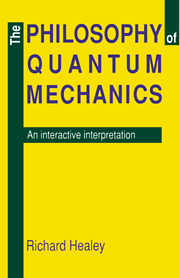6 - Alternatives compared
Published online by Cambridge University Press: 05 June 2012
Summary
After laying out the details of an interactive interpretation of (nonrelativistic) quantum mechanics, I shall now compare it to certain alternative approaches which have influenced its development. The main aim is to show how it differs from each of these, and to argue that these differences constitute significant improvements. But this explicit comparison may also foster a clearer understanding of the interactive interpretation itself, as well as showing how it is indebted to its predecessors.
NAIVE REALISM
Let me begin with the naive realist interpretation. Recall that, according to the naive realist, the Born rules specify probabilities for possessed values of dynamical variables. This is intimately connected to the naive realist assumptions: that a quantum system always has a dynamical state specifying a precise real value for every dynamical variable (PV), and that this is the value which a successful measurement of that dynamical variable would reveal (FM).
Though denying all three of these assumptions, the present interactive interpretation nevertheless agrees with the naive realist account on certain significant points. As opposed to the Copenhagen interpretation, both interpretations agree that a quantum system always has a dynamical state which is not derived from any quantum state. Furthermore, both interpretations agree that “statements concerning measurements can occur only as special instances viz., parts, of physical description to which I cannot ascribe an exceptional position above the rest.” Thus, in neither the naive realist interpretation nor the present interactive interpretation are the fundamental probabilities in quantum mechanics probabilities of measurement results.
- Type
- Chapter
- Information
- The Philosophy of Quantum MechanicsAn Interactive Interpretation, pp. 180 - 234Publisher: Cambridge University PressPrint publication year: 1989



